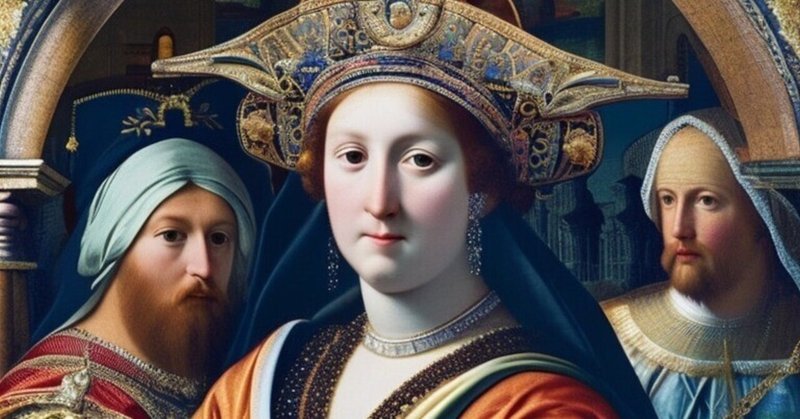
英語長文問題クエスト Part 95 (テーマ:ルネサンス)
英語の読解力を伸ばすには多読が必須!特に、TOEFL ibt というテストでは、かなり高度な読解力が必要ですし、何より、このTOEFL ibt という試験が難しいことの理由の1つに、日本語でも勉強していないアカデミックな内容の文章が出題されることです。
このクエストを進めれば、英語の読解力と知識を同時にアップデートさせられるでしょう!
さぁ、今日のクエストを進めてみましょう!
Passages
Title: Renaissance Art: A Cultural Revolution
The Renaissance, a period spanning roughly from the 14th to the 17th century, was a time of profound artistic, cultural, and intellectual transformation in Europe. During this era, there was a revival of interest in the classical art, literature, and knowledge of ancient Greece and Rome. This revival, often regarded as the birth of the modern world, had a significant impact on various artistic forms, laying the foundation for what is now considered Renaissance art.
Humanism and Artistic Expression
Central to Renaissance art was the humanist movement, which emphasized the study of classical texts, human dignity, and individual potential. Humanism profoundly influenced artists, encouraging them to depict the human body with greater accuracy and naturalism. Artists like Leonardo da Vinci and Michelangelo became renowned for their anatomically precise representations, capturing the essence of the human form and emotion in their works.
Perspective and Realism
Renaissance artists pioneered the use of linear perspective, a technique that created the illusion of depth and three-dimensionality on a flat surface. This innovation allowed artists to depict scenes with remarkable realism. The application of light and shadow, known as chiaroscuro, further enhanced the illusion, giving paintings a sense of depth and solidity. Artists such as Raphael and Titian mastered these techniques, creating artworks that appeared almost lifelike.
Innovation in Artistic Mediums
The Renaissance also witnessed innovations in artistic mediums. Oil painting, introduced in Northern Europe, allowed for richer colors and finer details in artworks. Artists could now achieve a greater range of tones and textures, enhancing the overall visual impact of their paintings. The availability of new pigments expanded the artist's palette, enabling a broader spectrum of colors and artistic expression.
Patronage and Artistic Centers
The flourishing of Renaissance art was closely tied to patronage. Wealthy individuals, including rulers, merchants, and the Church, commissioned artworks to enhance their prestige and reflect their cultural sophistication. Major Italian cities like Florence, Venice, and Rome became artistic hubs, fostering creativity and collaboration among artists, architects, and scholars. These centers of learning and creativity attracted talent from across Europe, leading to the exchange of ideas and techniques.
Legacy and Influence
The impact of Renaissance art extended far beyond its time. It laid the foundation for subsequent art movements, influencing styles like Baroque and Neoclassicism. The emphasis on individual creativity, technical mastery, and the representation of the natural world became enduring ideals in Western art. Even today, Renaissance masterpieces are celebrated and studied, serving as a testament to the enduring power and beauty of this transformative period in human history.
Questions:
What was a central focus of the Renaissance period?
A. Scientific discoveries
B. Classical art and knowledge
C. Industrial revolution
D. Religious dogmaWhich movement profoundly influenced artists during the Renaissance, leading to more accurate depictions of the human body?
A. Impressionism
B. Realism
C. Humanism
D. SurrealismWhat technique, pioneered during the Renaissance, created the illusion of depth and three-dimensionality in artworks?
A. Cubism
B. Linear perspective
C. Abstract expressionism
D. PointillismWhich artistic innovation allowed for richer colors and finer details in Renaissance paintings?
A. Watercolor painting
B. Fresco painting
C. Oil painting
D. Tempera paintingWhich Italian city was a major artistic center during the Renaissance, fostering creativity and collaboration among artists, architects, and scholars?
A. Milan
B. Florence
C. Naples
D. VeniceWhat enduring ideals in Western art were established during the Renaissance period?
A. Emphasis on minimalism and simplicity
B. Focus on abstraction and distortion
C. Emphasis on individual creativity and technical mastery
D. Focus on chaotic and disorganized compositionsWhat technique, involving the use of light and shadow, enhanced the illusion of depth and solidity in Renaissance paintings?
A. Tenebrism
B. Chiaroscuro
C. Sfumato
D. ImpastoWhich artist from the Renaissance period is renowned for his anatomically precise representations of the human body?
A. Raphael
B. Michelangelo
C. Titian
D. Van EyckWhat did the humanist movement emphasize, influencing artists to depict the human body more accurately?
A. Study of classical texts, human dignity, and individual potential
B. Focus on religious themes and symbolism
C. Exploration of abstract concepts and ideas
D. Study of non-Western cultures and traditionsWhat artistic technique was introduced during the Renaissance period, allowing artists to achieve a greater range of tones and textures?
A. Engraving
B. Etching
C. Oil painting
D. Tempera painting
Answers and Explanations
ここから先は
¥ 200
この記事が気に入ったらサポートをしてみませんか?
